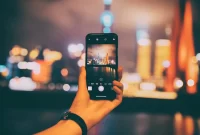Are you fascinated by those beautiful blurred backgrounds in photographs? In this article, we’ll guide you on how to create stunning bokeh effects with any camera, from smartphones to DSLRs. Discover the secrets to achieving gorgeous, dreamy backgrounds that will make your photos stand out!
Understanding Bokeh and its Importance in Photography
Bokeh is a term widely used in photography to describe the aesthetic quality of the out-of-focus areas in a photograph. It refers to the soft, blurred background or foreground that creates a sense of depth and separation from the main subject. Understanding bokeh and how to create it effectively can significantly enhance your photography skills.
Bokeh is essential as it helps the subject stand out by minimizing distracting elements in the background. By intentionally blurring the background, you can draw the viewer’s attention to the main subject, making it the focal point of the image. This technique is commonly used in portrait, nature, and macro photography, where the subject needs to be emphasized.
To create bokeh effects, you don’t necessarily need an expensive camera or lens. It primarily depends on the aperture setting and the distance between the subject and the background. A wider aperture, such as f/1.8 or lower, will produce a shallower depth of field, resulting in stronger bokeh. However, even with narrower apertures, you can still achieve a pleasing bokeh by moving closer to the subject or having more distance between the subject and the background.
Additionally, the type of lens you use can influence the quality of bokeh. Prime lenses with wider maximum apertures tend to provide smoother and more appealing bokeh compared to zoom lenses. However, this shouldn’t discourage you from experimenting with various lenses to find the desired bokeh effect for your photography.
In conclusion, understanding bokeh is crucial for photographers aiming to create visually pleasing images. By mastering bokeh techniques, you can add depth and dimension to your photos, capturing the viewer’s attention and enhancing the overall impact of your work.
Choosing the Right Lens for Stunning Bokeh
When it comes to creating beautiful bokeh effects in your photos, the right lens can make all the difference. Bokeh refers to the aesthetic quality of the out-of-focus areas in an image, and it can greatly enhance the overall impact of your photographs.
Here are a few factors to consider when selecting a lens for stunning bokeh:
- Wide Aperture: Look for lenses with a wide maximum aperture, such as f/1.4 or f/1.8. A wider aperture allows more light to enter the lens, resulting in a shallower depth of field and more pronounced bokeh.
- Prime Lenses: Prime lenses, also known as fixed focal length lenses, tend to produce better bokeh compared to zoom lenses. Their simpler optical design and wider apertures contribute to creamy and smooth backgrounds.
- Long Focal Length: Telephoto lenses with longer focal lengths are ideal for creating strong bokeh. The compression effect created by these lenses brings the subject closer and makes the background appear more out-of-focus.
- Quality Optics: Investing in lenses with high optical quality is essential for achieving stunning bokeh. Good quality lenses will minimize aberrations and deliver sharper, more pleasing bokeh.
By considering these factors, you can choose the right lens that will help you achieve stunning bokeh effects in your images. Experimenting with different lenses and techniques will further enhance your ability to create captivating and mesmerizing photographs.
Mastering Aperture Settings for Bokehlicious Shots
Bokeh effects can add a touch of magic to your photographs, giving them a dreamy and ethereal quality. One of the key factors in achieving stunning bokeh is mastering aperture settings. In this article, we will guide you through the process of creating bokeh effects with any camera by understanding and manipulating aperture settings.
1. Understanding Aperture
Aperture refers to the opening in your camera’s lens that allows light to pass through. It is measured in f-stops, with larger numbers representing smaller openings and vice versa. A wider aperture (smaller f-stop number) will create a shallow depth of field, resulting in a blurred background and a sharp subject.
2. Selecting the Right Lens
To achieve beautiful bokeh, it’s advisable to use a lens with a wide maximum aperture, such as f/1.8 or f/1.4. These lenses allow more light to enter, enabling you to create a shallower depth of field and enhance the bokeh effect.
3. Shooting in Manual Mode
Switch to manual mode on your camera to have full control over the aperture settings. By doing so, you can experiment with different f-stop values and determine the desired level of bokeh for your shots.
4. Distance from Subject
The distance between your subject and the background also affects the bokeh. The closer your subject is to the camera and the further away the background is, the more prominent the bokeh effect will be.
5. Lens Focal Length
Longer focal lengths, such as 85mm or 100mm, generally produce smoother and creamier bokeh. Experiment with different focal lengths to achieve the desired bokeh effect.
6. Shooting in Low Light
Low light conditions tend to enhance bokeh, so try shooting during sunrise, sunset, or in dimly lit environments to make your bokeh shots even more mesmerizing.
7. Post-Processing
If you want to fine-tune your bokeh, you can also enhance it during post-processing. Software like Photoshop or Lightroom offers various tools and filters to further manipulate and accentuate the bokeh effect in your images.
Exploring Creative Techniques to Enhance Bokeh Effects
Bokeh effects are a popular technique in photography that can add depth and visual interest to your images. Whether you are using a professional DSLR or a smartphone camera, there are various creative techniques you can try to enhance your bokeh effects.
1. Choosing the right lens
One of the key factors in achieving beautiful bokeh is choosing the right lens. A lens with a wide aperture, such as f/1.8 or f/2.8, allows more light to enter the camera, creating a shallow depth of field and a creamy bokeh effect. Prime lenses are often preferred for this purpose.
2. Selecting the right subject
The subject you choose can greatly impact the bokeh effect in your photo. Objects with shiny or reflective surfaces, such as water droplets, Christmas lights, or city lights, can create stunning bokeh. Experiment with different subjects to find what works best for you.
3. Controlling the distance
The distance between your subject, the background, and your camera plays a crucial role in determining the bokeh effect. To achieve a more pronounced bokeh, try placing your subject close to the camera while keeping the background at a greater distance.
4. Utilizing foreground elements
Adding foreground elements can enhance the overall composition and create a more dynamic bokeh effect. You can use objects such as leaves, branches, or other elements to add depth and interest to your photos.
5. Experimenting with manual settings
While many cameras have a bokeh mode or portrait mode that automatically blurs the background, experimenting with manual settings can give you more control over the bokeh effect. Adjusting the aperture, shutter speed, and ISO can produce unique results.
By exploring these creative techniques and experimenting with different elements, you can enhance the bokeh effects in your photos and take your photography skills to the next level.
Conclusion
In conclusion, creating bokeh effects with any camera is a simple yet effective way to enhance your photography. By understanding the concept of depth of field, using a wide aperture, and strategically placing your subject, you can achieve beautiful, blurred backgrounds that make your subject stand out. Experiment with different lenses and lighting conditions to further enhance the bokeh effect and push your creativity to new heights.




